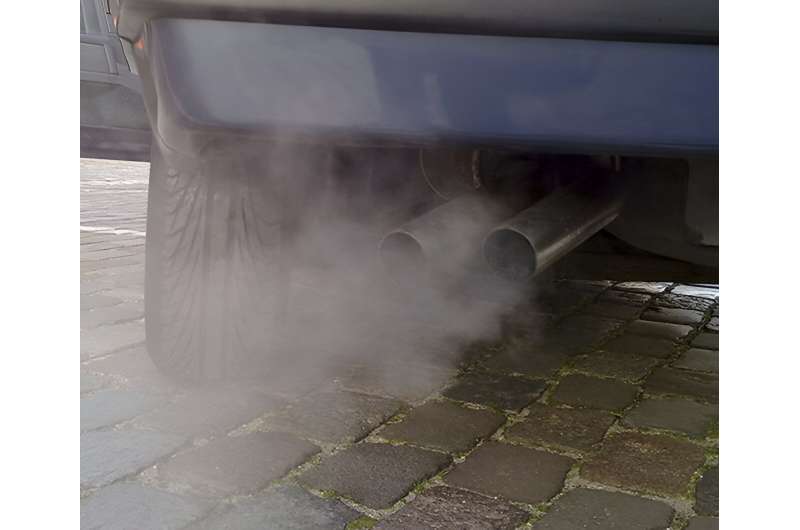
The growing concerns about air pollution and its harmful effects on human health and climate change have led to increasingly stringent vehicular emission norms. These regulations have contributed to significant reductions in carbon monoxide, hydrocarbons, nitrogen oxides, and particulate matter from transportation sources. The European Union’s Euro 7 standard, set to take effect in 2026, further tightens these limits by establishing a threshold for 10 nanometer particulate matter emissions and requiring low-temperature emissions testing at -7°C.
To help improve combustion processes and reduce particulate emissions, researchers at Doshisha University have revealed how fuel spray forms wall films inside direct injection engines. Their findings, published in Fuel, provide valuable insights into the effects of cold conditions on wall film formation and its contribution to particulate matter emissions.
The research team was led by Dr. Dai Matsuda, a former doctoral student at Doshisha University who is now a researcher at the National Institute of Advanced Industrial Science and Technology, and included Jiro Senda and Eriko Matsumura from Doshisha University, Japan.
Direct fuel injection vehicles have gained popularity due to their higher fuel efficiency, with savings of 10 to 20% compared to port injection systems. In 2020, 55% of light-duty vehicles in the United States were equipped with direct-injection engines. However, injecting fuel so close to the engine reduces the time available for fuel to evaporate and mix with air, leading to a richer fuel mixture and increased deposition on cylinder walls. This can result in incomplete combustion and higher levels of particulate matter in the exhaust.
“When a certain amount of fuel is injected, some of it impinges on the wall, some of it adheres to the wall, and the amount of wall film that does not break up is the final amount. Our research aims to clarify the relationship between phenomena and mass in the process of wall film formation,” explains Dr. Matsuda.
To simulate the formation of wall films on engine cylinder walls, the researchers injected isooctane into a wall surface whose temperature and injection pressure could be controlled. Isooctane was chosen because it behaves similarly to gasoline at low temperatures.
In the setup, isooctane was injected at a 45-degree angle onto a wall surface through an injector cooled with dry ice. The temperature of the wall surface was regulated using a heat exchanger bonded directly to its sides. The wall surface was then housed in a container sealed with nitrogen to eliminate the effects of moisture present in the air.
The researchers used two methods to measure the mass of fuel spray that adheres to the wall: an absorption method that involves weighing a sanitary napkin placed on the wall after fuel injection, and the Total Internal Reflection Laser-Induced Fluorescence (TIR-LIF) method, which uses a laser to detect fluorescence from markers mixed with the fuel.
The experiments found that as the fuel spray impacts the wall, more fuel adheres to it over time, causing the wall film to thicken. This thickness reaches its maximum by the end of the spray. After this peak, the amount of fuel adhering to the wall drops quickly and then stabilizes. This indicates that the wall film breaks up after the spray has stopped.
At a fuel injection temperature of 253 Kelvin (K) (-20.15°C), the spray wall impingement ratio (which is the ratio of the amount of fuel that impinges on the wall to the total amount of fuel injected) increased by 8.4% compared to 293 K (19.85°C). This increase occurs because colder fuel is more viscous and does not atomize as effectively, leading to fewer but larger droplets hitting the wall.
However, the larger droplets adhere less efficiently than smaller, more dispersed droplets and eventually fall off the film after the spray has stopped. Additionally, higher injection pressures caused more fuel to splash against the wall, reducing the final amount of fuel adhering to the wall.
“Cold fuel increases the ratio of spray impingement, leading to a higher ratio of wall adhesion,” explains Dr. Matsuda.
These findings provide a detailed understanding of wall film formation, which can aid in optimizing fuel injection strategies and developing cleaner, more efficient direct injection engines.
More information:
Dai MATSUDA et al, Experimental analysis of spray impingement wall film at cold temperatures for Direct-Injection spark ignition engines, Fuel (2024). DOI: 10.1016/j.fuel.2024.132407
Doshisha University
Analysis of spray impingement and wall film formation in direct injection engines (2024, August 27)
retrieved 27 August 2024
from https://techxplore.com/news/2024-08-analysis-spray-impingement-wall-formation.html
part may be reproduced without the written permission. The content is provided for information purposes only.

The growing concerns about air pollution and its harmful effects on human health and climate change have led to increasingly stringent vehicular emission norms. These regulations have contributed to significant reductions in carbon monoxide, hydrocarbons, nitrogen oxides, and particulate matter from transportation sources. The European Union’s Euro 7 standard, set to take effect in 2026, further tightens these limits by establishing a threshold for 10 nanometer particulate matter emissions and requiring low-temperature emissions testing at -7°C.
To help improve combustion processes and reduce particulate emissions, researchers at Doshisha University have revealed how fuel spray forms wall films inside direct injection engines. Their findings, published in Fuel, provide valuable insights into the effects of cold conditions on wall film formation and its contribution to particulate matter emissions.
The research team was led by Dr. Dai Matsuda, a former doctoral student at Doshisha University who is now a researcher at the National Institute of Advanced Industrial Science and Technology, and included Jiro Senda and Eriko Matsumura from Doshisha University, Japan.
Direct fuel injection vehicles have gained popularity due to their higher fuel efficiency, with savings of 10 to 20% compared to port injection systems. In 2020, 55% of light-duty vehicles in the United States were equipped with direct-injection engines. However, injecting fuel so close to the engine reduces the time available for fuel to evaporate and mix with air, leading to a richer fuel mixture and increased deposition on cylinder walls. This can result in incomplete combustion and higher levels of particulate matter in the exhaust.
“When a certain amount of fuel is injected, some of it impinges on the wall, some of it adheres to the wall, and the amount of wall film that does not break up is the final amount. Our research aims to clarify the relationship between phenomena and mass in the process of wall film formation,” explains Dr. Matsuda.
To simulate the formation of wall films on engine cylinder walls, the researchers injected isooctane into a wall surface whose temperature and injection pressure could be controlled. Isooctane was chosen because it behaves similarly to gasoline at low temperatures.
In the setup, isooctane was injected at a 45-degree angle onto a wall surface through an injector cooled with dry ice. The temperature of the wall surface was regulated using a heat exchanger bonded directly to its sides. The wall surface was then housed in a container sealed with nitrogen to eliminate the effects of moisture present in the air.
The researchers used two methods to measure the mass of fuel spray that adheres to the wall: an absorption method that involves weighing a sanitary napkin placed on the wall after fuel injection, and the Total Internal Reflection Laser-Induced Fluorescence (TIR-LIF) method, which uses a laser to detect fluorescence from markers mixed with the fuel.
The experiments found that as the fuel spray impacts the wall, more fuel adheres to it over time, causing the wall film to thicken. This thickness reaches its maximum by the end of the spray. After this peak, the amount of fuel adhering to the wall drops quickly and then stabilizes. This indicates that the wall film breaks up after the spray has stopped.
At a fuel injection temperature of 253 Kelvin (K) (-20.15°C), the spray wall impingement ratio (which is the ratio of the amount of fuel that impinges on the wall to the total amount of fuel injected) increased by 8.4% compared to 293 K (19.85°C). This increase occurs because colder fuel is more viscous and does not atomize as effectively, leading to fewer but larger droplets hitting the wall.
However, the larger droplets adhere less efficiently than smaller, more dispersed droplets and eventually fall off the film after the spray has stopped. Additionally, higher injection pressures caused more fuel to splash against the wall, reducing the final amount of fuel adhering to the wall.
“Cold fuel increases the ratio of spray impingement, leading to a higher ratio of wall adhesion,” explains Dr. Matsuda.
These findings provide a detailed understanding of wall film formation, which can aid in optimizing fuel injection strategies and developing cleaner, more efficient direct injection engines.
More information:
Dai MATSUDA et al, Experimental analysis of spray impingement wall film at cold temperatures for Direct-Injection spark ignition engines, Fuel (2024). DOI: 10.1016/j.fuel.2024.132407
Doshisha University
Analysis of spray impingement and wall film formation in direct injection engines (2024, August 27)
retrieved 27 August 2024
from https://techxplore.com/news/2024-08-analysis-spray-impingement-wall-formation.html
part may be reproduced without the written permission. The content is provided for information purposes only.






